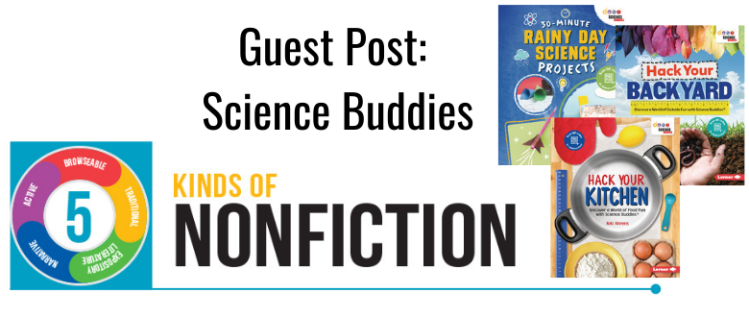A World of Hands-On STEM Discovery:Active Nonfiction

This is a guest post by our publishing partner, Science Buddies, a website which offers hands-on science resources for home and school.
What can kids learn by dropping bouncy balls into a container filled with flour? This simple activity brings the formation of craters to life for kids. As they try balls of different sizes, they see science in action and add to the information they know about the world around them.
Our mission at Science Buddies is to make hands-on science and engineering learning available to all children. Exploring science, technology, engineering, and math (STEM) doesn’t always mean going to a lab or doing a school assignment. Some of the most meaningful STEM learning happens in more informal settings and when kids are learning by doing for the fun of it. Doing science at home is a great way to focus on the fun of learning and discovery, and our series of books with Lerner Publishing Group helps us reach even more kids so that they have the opportunity to try hands-on STEM with activities that are fun and easy to do at home.
The activities in our books make it possible for kids to jump in and explore on their own or with their families, and the short science explanations help bridge the gap between what kids observe when doing an activity and why that is happening. Books in the 30-Minute Makers series, along with Hack Your Backyard and Hack Your Kitchen, contain science and engineering activities on engaging themes that reinforce for kids that science is fun and help them discover activities that match their unique interests. Our newest title, Hack Your Kitchen, contains a fun mix of kitchen chemistry, like making edible paper, and innovative hands-on physics and engineering activities, like creating a really, really long drinking straw or baking ice cream. All of the projects work with materials families might already have on hand or can easily add to a grocery list.
After doing activities in a collection like Hack Your Kitchen, we hope kids are excited about science and engineering, more aware of the ways in which science and engineering are all around us, including in the kitchen, and empowered about their own ability to do science.
Every kid deserves the opportunity to discover the scientist within. Hands-on activities make that process accessible and lots of fun.
Active Nonfiction is a category of Melissa Stewart’s Five Kinds of Nonfiction. This post is part of a weekly series of guest articles by nonfiction authors about their craft, their process, and their amazing books. Stay tuned each week to learn more by visiting the 5 Kinds of Nonfiction page for poster and flyer downloads, curated booklists and more. You can also follow the Lerner Blog’s 5 Kinds of Nonfiction series, or the hashtag #5KNF on Facebook, Twitter, Instagram, and LinkedIn.


Comments